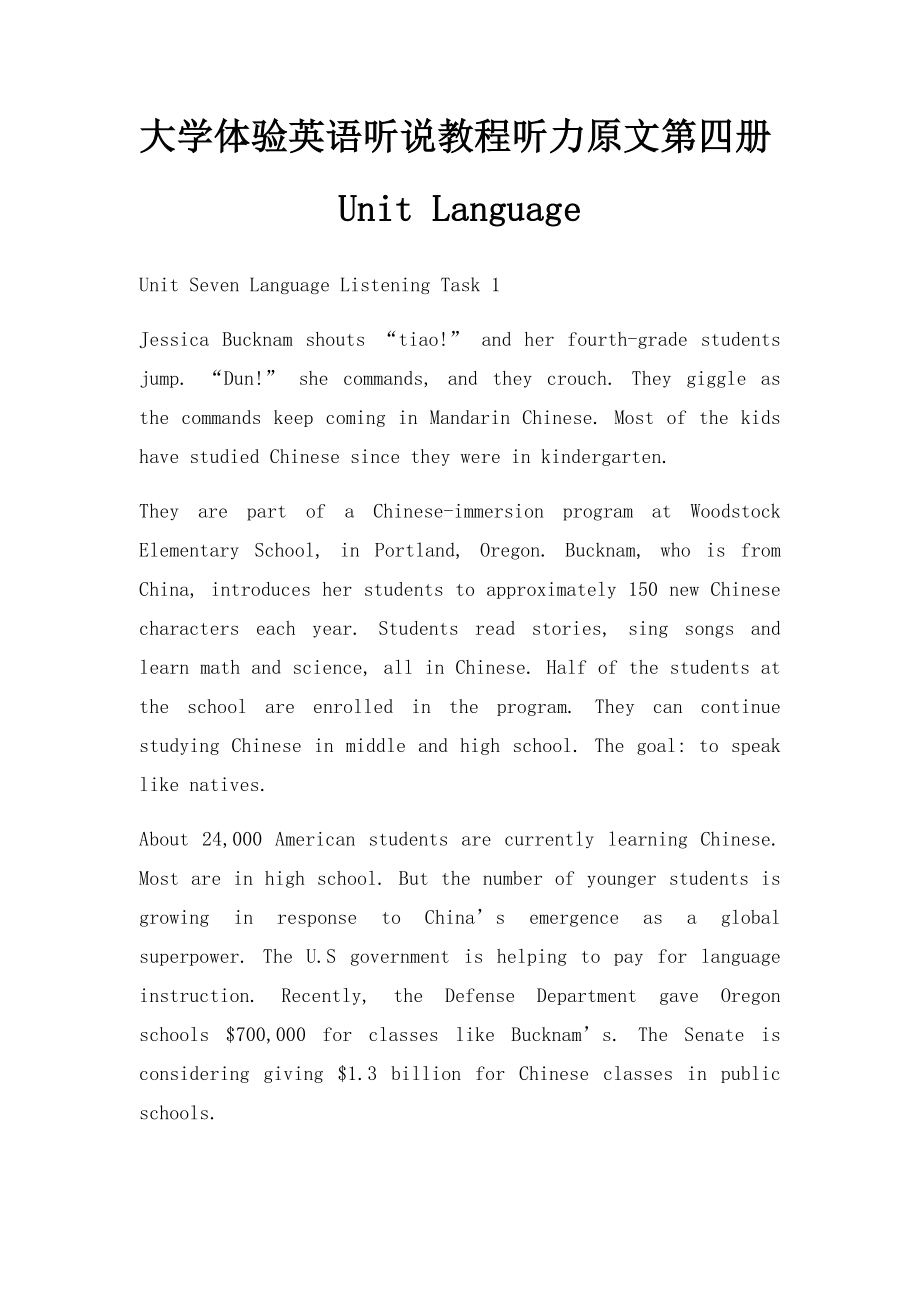 大学体验英语听说教程听力原文第四册Unit Language
大学体验英语听说教程听力原文第四册Unit Language



《大学体验英语听说教程听力原文第四册Unit Language》由会员分享,可在线阅读,更多相关《大学体验英语听说教程听力原文第四册Unit Language(4页珍藏版)》请在装配图网上搜索。
1、大学体验英语听说教程听力原文第四册Unit LanguageUnit Seven Language Listening Task 1 Jessica Bucknam shouts “tiao!” and her fourth-grade students jump. “Dun!” she commands, and they crouch. They giggle as the commands keep coming in Mandarin Chinese. Most of the kids have studied Chinese since they were in kindergart
2、en. They are part of a Chinese-immersion program at Woodstock Elementary School, in Portland, Oregon. Bucknam, who is from China, introduces her students to approximately 150 new Chinese characters each year. Students read stories, sing songs and learn math and science, all in Chinese. Half of the s
3、tudents at the school are enrolled in the program. They can continue studying Chinese in middle and high school. The goal: to speak like natives. About 24,000 American students are currently learning Chinese. Most are in high school. But the number of younger students is growing in response to China
4、s emergence as a global superpower. The U.S government is helping to pay for language instruction. Recently, the Defense Department gave Oregon schools $700,000 for classes like Bucknams. The Senate is considering giving $1.3 billion for Chinese classes in public schools. “China has become a stong p
5、artner of the United States,” says Mary Patterson, Woodstocks principal. “Children who learn Chinese at a young age will have more opportunities for jobs in the future.” Isabel Weiss, 9, isnt thinking about the future. She thinks learning Chinese is fun. “When you hear people speaking in Chinese, yo
6、u know what theyre saying,” she says. “And they dont know that you know.” Want to learn Chinese? You have to memorize 3,500 characters to really know it all! Start with these Chinese characters and their pronunciations. Listening Task 2 An idiom is an expression whose meaning cannot be deduced from
7、the literal definitions and the arrangement of its parts, but refers instead to a figurative meaning that is known only through conventional use. In the English expression to kick the bucket, a listener knowing only the meaning of kick and bucket would be unable to deduce the expressions actual mean
8、ing, which is to die. Although kick the bucket can refer literally to the act of striking a bucket with a foot, native speakers rarely use it that way. Idioms hence tend to confuse those not already familiar with them; students of a new language must learn its idiomatic expressions the way they lear
9、n its other vocabulary. In fact many natural language words have idiomatic origins, but have been sufficiently assimilated so that their figurative senses have been lost. Interestingly, many Chinese characters are likewise idiomatic constructs, as their meanings are more often not traceable to a lit
10、eral meaning of their assembled parts, or radicals. Because all characters are composed from a relatively small base of about 214 radicals, their assembled meanings follow several different modes of interpretation from the pictographic to the metaphorical to those whose original meaning has been los
11、t in history. Real world listening Q: Why are some idioms so difficult to be understood outside of the local culture? A: Idioms are, in essence, often colloquial metaphors terms which requires some foundational knowledge, information, or experience, to use only within a culture where parties must ha
12、ve common reference. As cultures are typically localized, idioms are more often not useful for communication outside of that local context. Q: Are all idioms translatable across languages? A: Not all idioms are translatable. But the most common idioms can have deep roots, traceable across many langu
13、ages. To have blood on ones hands is a familiar example, whose meaning is obvious. These idioms can be more universally used than others, and they can be easily translated, or their metaphorical meaning can be more easily deduced. Many have translations in other languages, and tend to become interna
14、tional. Q: How are idioms different from others in vocabulary? A: First, the meaning of an idiom is not a straightforward composition of the meaning of its parts. For example, the meaning of kick the bucket has nothing to do with kicking buckets. Second, one cannot substitute a word in an idiom with a related word. For example, we can not say kick the pail instead of kick the bucket although bucket and pail are synonyms. Third, one can not modify an idiom or apply syntactic transformations. For example, John kicked the green bucket or the bucket was kicked has nothing to do with dying.
- 温馨提示:
1: 本站所有资源如无特殊说明,都需要本地电脑安装OFFICE2007和PDF阅读器。图纸软件为CAD,CAXA,PROE,UG,SolidWorks等.压缩文件请下载最新的WinRAR软件解压。
2: 本站的文档不包含任何第三方提供的附件图纸等,如果需要附件,请联系上传者。文件的所有权益归上传用户所有。
3.本站RAR压缩包中若带图纸,网页内容里面会有图纸预览,若没有图纸预览就没有图纸。
4. 未经权益所有人同意不得将文件中的内容挪作商业或盈利用途。
5. 装配图网仅提供信息存储空间,仅对用户上传内容的表现方式做保护处理,对用户上传分享的文档内容本身不做任何修改或编辑,并不能对任何下载内容负责。
6. 下载文件中如有侵权或不适当内容,请与我们联系,我们立即纠正。
7. 本站不保证下载资源的准确性、安全性和完整性, 同时也不承担用户因使用这些下载资源对自己和他人造成任何形式的伤害或损失。
